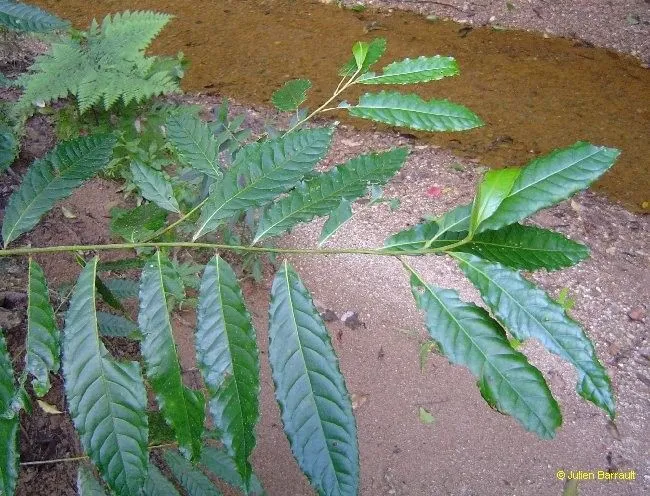
Author: Blume
Bibliography: Bijdr. Fl. Ned. Ind.: 120 (1825)
Year: 1825
Status: accepted
Rank: species
Genus: Elaeocarpus
Vegetable: False
Observations: Himalaya to China (Yunnan, Guangxi) and SW. Pacific
The Blue Marble Tree, scientifically known as Elaeocarpus angustifolius, is an intriguing and striking tree species that belongs to the Elaeocarpaceae family. First described by the renowned botanist Blume in the early 19th century, specifically in the year 1825 as part of his comprehensive work documented in “Bijdragen tot de Flora van Nederlandsch Indië,” it has captured the attention of botanists and horticultural enthusiasts alike.
This majestic tree is primarily observed throughout an extensive range stretching from the Himalayas to China, including the regions of Yunnan and Guangxi, and extending southwest to the vast expanses of the Pacific. Such a wide distribution highlights the Blue Marble Tree’s adaptability to various climatic conditions and its ecological significance across different landscapes.
One of the most striking features of Elaeocarpus angustifolius is its beautifully patterned bark, which peels away in thin, papery sheets. Complementing its distinctive bark, the tree bears elongated, lance-shaped leaves with finely serrated edges that provide a lush, green canopy throughout the year.
During the blooming season, the Blue Marble Tree produces a profusion of small, white, fringed flowers that emit a subtle, pleasant fragrance, attracting a variety of pollinators. These flowers give way to its unique, marble-like blue fruits, which not only add to the ornamental appeal of the tree but also serve as a source of food for wildlife, including birds and other small animals.
In addition to its aesthetic and ecological values, the Blue Marble Tree has cultural significance in various regions. It is often utilized in traditional medicinal practices and has various applications, ranging from timber to ornamental landscaping. Its remarkable resilience and ornamental beauty make it a favored choice for urban greening projects and large gardens where its expansive canopy can provide ample shade and enhance biodiversity.
Thus, the Blue Marble Tree stands as a testament to nature’s intricate beauty and the rich botanical heritage described by Blume nearly two centuries ago.
Eng: blue marble tree, blue-fig, blue-quandong
En: Blue marble tree, Blue-fig, Blue-quandong, Blue Quandong Fruit
© copyright of the Board of Trustees of the Royal Botanic Gardens, Kew.
© copyright of the Board of Trustees of the Royal Botanic Gardens, Kew.
© copyright of the Board of Trustees of the Royal Botanic Gardens, Kew.
Taken Nov 25, 2017 by Endemia – Benoît Henry (cc-by-nc)
Taken Nov 13, 2011 by Endemia – Benoît Henry (cc-by-nc)
Taken Jul 17, 2021 by Zoé Thivet (cc-by-sa)
Taken Aug 14, 2011 by Daniel Barthelemy (cc-by-sa)
Taken Aug 14, 2011 by Daniel Barthelemy (cc-by-sa)
Taken Jan 1, 1970 by Endemia – Julien Barrault (cc-by-nc)
Taken Jan 1, 1970 by Endemia – Julien Barrault (cc-by-nc)
Taken Jan 1, 1970 by Endemia – Julien Barrault (cc-by-nc)
Taken Jan 1, 1970 by Endemia – Jean-Jacques Villegente (cc-by-nc)
Taken Jan 1, 1970 by Endemia – Julien Barrault (cc-by-nc)
Taken Jul 26, 2021 by christiane Fazer (cc-by-sa)
Taken Oct 18, 2022 by Alboss (cc-by-sa)
Taken Oct 26, 2021 by andrew Andrew (cc-by-sa)
Taken Dec 23, 2020 by Ravi Bhat (cc-by-sa)
Taken Jan 1, 1970 by Endemia – Julien Barrault (cc-by-nc)
Taken Jul 26, 2021 by christiane Fazer (cc-by-sa)
Taken Oct 18, 2022 by Alboss (cc-by-sa)
Family: Myrtaceae Author: (F.Muell.) K.D.Hill & L.A.S.Johnson Bibliography: Telopea 6: 402 (1995) Year: 1995 Status:…
Family: Rubiaceae Author: Pierre ex A.Froehner Bibliography: Notizbl. Bot. Gart. Berlin-Dahlem 1: 237 (1897) Year:…
Family: Sapindaceae Author: Koidz. Bibliography: J. Coll. Sci. Imp. Univ. Tokyo 32(1): 38 (1911) Year:…
Family: Asteraceae Author: A.Gray Bibliography: Pacif. Railr. Rep.: 107 (1857) Year: 1857 Status: accepted Rank:…
Family: Fabaceae Author: Medik. Bibliography: Vorles. Churpfälz. Phys.-Ökon. Ges. 2: 398 (1787) Year: 1787 Status:…
Family: Aspleniaceae Author: (Cav.) Alston Bibliography: Bull. Misc. Inform. Kew 1932: 309 (1932) Year: 1932…